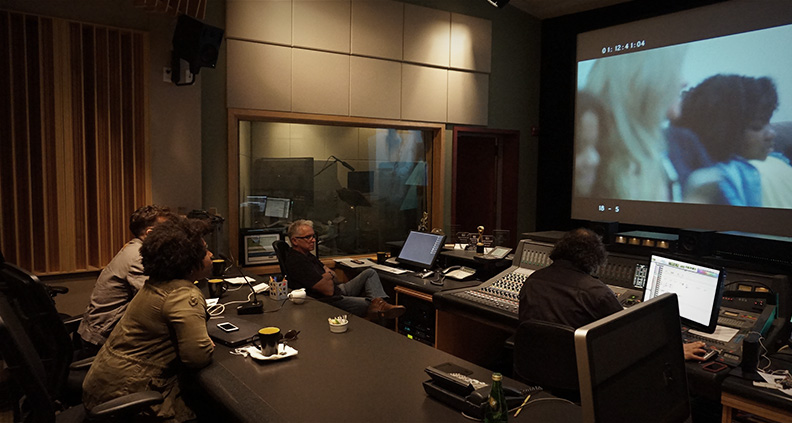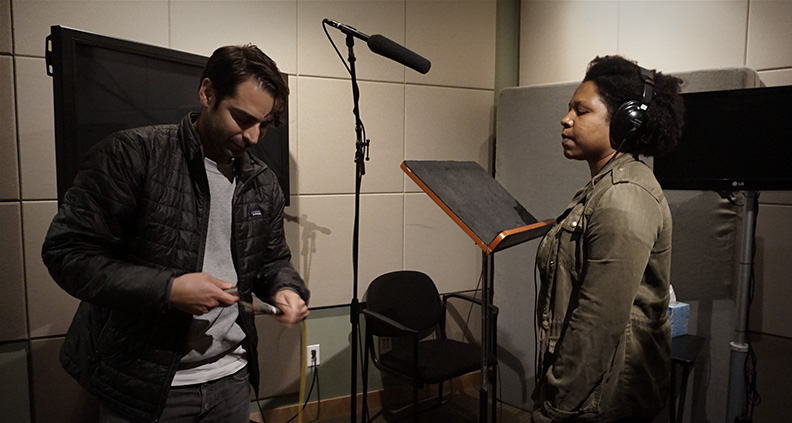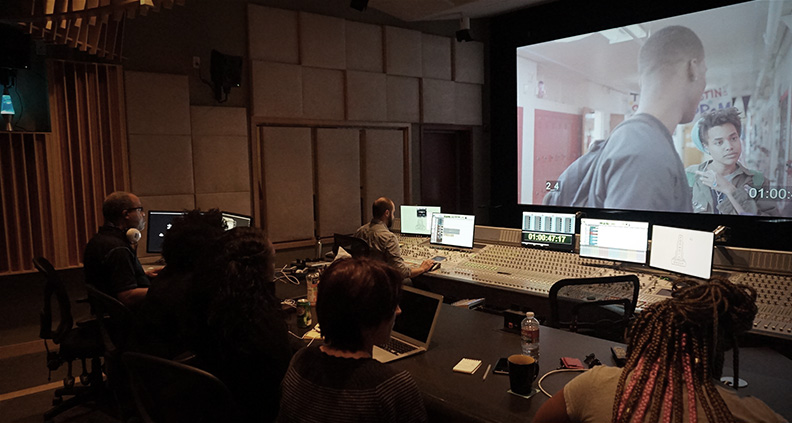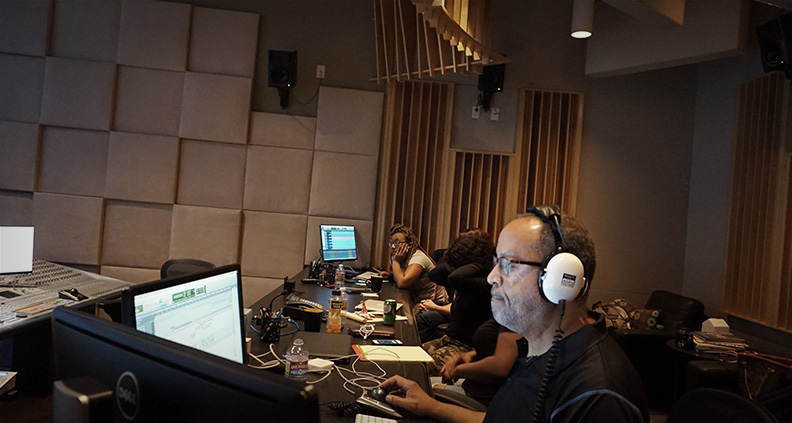Post-Production Sound and Project Involve: Building the Aural Environment
The late deadline for Film Independent Members to apply to the 2023 session of Project Involve—the program’s 30th anniversary!—is TOMORROW, September 7. To encourage you to finish up (or start!) those applications, we’re re-posting this piece from 2017, about the Project Involve shorts post-production sound process.
***
People often say: “film is a visual medium.” But really, what we hear is just as important as what we see. After all, sound is fully one-half of the experience of watching movies. Good sound can convey important plot information and add texture in ways that are often as imperceptible as they are effective. Conversely, a movie with bad sound is infinitely more likely to send audiences scrambling for the exit than one with poor picture quality. It’s a lesson that benefits any young filmmaker to embrace—including this year’s Project Involve Fellows.
As part of Film Independent’s flagship diversity-focused mentorship initiative and filmmaker workshop, this year’s Project Involve Fellows (learn who they are by clicking here) collaborated together on the production of a series of seven short films: Emergency, Eve, Great Again, Suitable, The Mud, The Station, and This Little Light.
Great Again (writer: Aeden Keffelew; producer: Valerie Castillo Martinez; director: Christopher de las Alas; cinematographer: Andrea Gonzalez Mereles) No one knows when his or her lucky day will come, but everyone’s hoping it’s today. Hope and despair, sanity and insanity ensue when a homeless man wins the lotto.
The Station (writer: Jimmy Mosqueda; producer: Carolyn Mao; director: Daniel Foerste; cinematographer: Kazmo Kida) At a bus station on Christmas Eve, an emotionally closed-off man is visited by a stranger and must figure out the terms of his relationship with his estranged brother.
Suitable (writer: Rochee Jeffrey; producer: Ashley Chrisman; director: Thembi Banks; cinematographer: Dennis Zanatta) A tomboy comes into her own when she decides not to wear a dress to prom.
This Little Light (writer: Ebony Gilbert; producer: Kady Kamakate; director: Esteban Arango; cinematographer: Farhad Ahmed Dehlvi) A desperate mother is determined to help her daughter deal with schizophrenia—an issue not commonly addressed in the Black community.

Emergency (writer: Kristen Davila; producer: Joenique Rose; director: Carey Williams; cinematographer: Jomo Fray) A group of non-white guys are afraid to call the police when they need them.
Eve (writer: Diana Ly; producer: Marion Brooks; director: Brittany “B.Monét” Fennell; cinematographer: Kalilah Robinson) Set in a dystopian future, biblical Eve has a dream that changes the trajectory of life as we know it.
The Mud (medium: Stop motion clay animation; writer/director/animator: Brandon Lake; producers: Valerie Martinez, Carolyn Mao) A dancing man of clay tries to escape his identity, only to later realize its true beauty.
And to ensure that each of these films both looked great and sounded professional, this year’s P.I. Fellows worked in close collaboration with the veteran Sound Mixers and Supervising Sound Editors at Formosa Group in Los Angeles.
We recently spoke to some of this year’s Project Involve Fellows, as well as the supervising sound editors at Formosa Group, about their experiences weaving together the aural side of this year’s short films. First up, let’s hear from the Fellows.
PROJECT INVOLVE

Did anything surprise you about the film once you reached the sound mixing/sound editing stage?
Early on I made a decision to not use a score on the film. In the edit there were moments that felt that they called for some kind of score. The pleasant surprise was getting into sound design and discovering how much the design fleshed out those moments. (Carey Williams, director, Emergency)
We wanted to incorporate a lot of genre elements into the tone of the film. We moved the camera and blocked several sequences to fit this approach, but it wasn’t until we got to the post sound stage that the film really reflected those qualities. I think we accomplished what we set out to do, which was to ground our audience at certain moments in the experience of being afflicted with schizophrenia. We played with the sound perspective and tension to create a level of discomfort that was really moving. (Esteban Arango, Director, This Little Light)
What was the process like finishing your Project Involve film at this level?
I felt like I was coming to the table with what I felt were a lot of ideas and desires for sound on the film. I showed up and Peter was already several steps ahead of me. He and Tim had ideas and observations that I hadn’t even thought of that all really made a huge difference. I learned a lot working with them. (Daniel Foerste, director, The Station)
I’m a very visual director but also love sound. I don’t think that supervising sound editors and designers get the credit they rightfully deserve in helping to make a piece come to fruition. I sent Dave a lot of score and soundtracks that were doing interesting things and I wanted us to experiment and have fun. (Brittany “B. Monet” Fennel, Director, Eve)
What was the most valuable lesson you learned about sound on this film?
I already knew that you should always ensure that you record the best production sound possible. But I also learned to take even greater consideration in pre-production and examining the story and planning shots to consider post-production sound in advance to drive a moment or a scene. (Foerste)
Every project I learn more and more about the importance of recording good sound in the field. According to Chris, we got good field recording that helped him with the design. One thing I did learn, although I kind of already knew it, is to get lines clean even if the intention is to have the dialogue overlapping. Get it clean at some point to help with editing in post. (Williams)
That working with people who are not only skilled, but also have a similar passion for your project, makes the entire process feel like a dream. (Brandon Lake, Writer/Director/Animator, The Mud)

What were some of the elements that were most important in terms of how you used sound to tell your story?
I wanted an Afro-futurist feel, even though we were in space. It was important for me to be making a different space movie we have not necessarily seen before, and I wanted to make the sounds we hear both distinct and specific in certain moments. Without their assistance we would not have the same movie. (Fennel)
One of our characters is afflicted by schizophrenia. All along, we wanted to create that experience for our audience to build empathy. We did a lot of research into the types of voices that our character would hear in her head and the quality those voices would have. Recording those voices with the right tone that would feel claustrophobic and intimate, and then panning them in the surround mix was really important for our story. (Arango)
What films make you realize that sound was such an important part of the filmmaking process?
I’m a very big horror film fan—a genre that I feel very greatly utilizes sound to build suspense, sometimes to very hackneyed results. But I definitely think growing up indulging in those films has amplified my excitement when it comes to sound design in film, regardless of the genre. (Foerste)
Recently, the final episode of HBO’s Big Little Lies really struck me in how powerful the absence of score can be. (Williams)
Some references for us were The Handmaid’s Tale and Arrival. I love how these two unique pieces of art have amazing story and is complemented by sound. My goal was to honor the story and to always be surrounded by filmmakers and collaborators who also are consumed with story and are not afraid to honor that at every point, even if that means going against our initial plan. (Fennel)
What sound editing/mixing moment in the project are you the most proud of? What was the biggest challenge?
Tonally, the film rides a line between comedy and drama, and although I wanted the film to end on a moment of thoughtfulness and reflection, I didn’t want it to be down and betray the comedic tone of the film. (Williams)
I’m most proud of the arc of emotion that we were able to create. From silence that leads to chaos and eventually warmth, we take the audience on a journey that is beautifully strengthened by both the sound design and the score. (Lake)
Getting the right performance of the two voices in my character’s head, which were two little girls saying really mean things, was very challenging. It felt seamless and coherent, and we were able to create a poignant cinematic moment that lets the audience understand the tough experience the character is going through. (Arango)
THE FORMOSA GROUP

Now, let’s turn our finely attuned ears to the veteran sound team at the Formosa Group and learn what it was like working with this year’s P.I. Fellows and a little bit more about the sound SFX editing-and-mixing process:
What excites you about collaborating with emerging filmmakers?
I get energized when other people are excited by my work. Emerging filmmakers are open to new ideas and really appreciate the work we do. Their sensibilities are a clean slate and aren’t tarnished by the conventions that everyone else uses. (Greg Hedgepath, Supervising Sound Designer/Editor, Suitable)
In a word: enthusiasm. I’ve been doing this for a while, and while I still feel motivated by every project I work on, the enthusiasm is infectious. (Dave McMoyler, Supervising Sound Designer/Editor, Eve and This Little Light)
I enjoy a new fresh perspective and new filmmakers think outside the box and aren’t afraid to try non-traditional ideas. I also enjoy sharing post-production sound knowledge. (D. Chris Smith, Supervising Sound Designer/Editor, Emergency)
What were the most important elements in terms of the use of sound in the P.I. short you worked on?
Building an environment for the story to take place in is very important, because it accents the believability of the story. Once that was handled, the next important thing for Great Again was to accent those elements in the film that were story points. The mouthwash bottle was an important plot device, so we needed to keep that alive, sound-wise, which helped the comedy. (Odin Benitez, Supervising Sound Designer/Editor, Great Again)
The environments, the police, the ambulance, the off-stage dogs and people. Also: twice in the film we went inside the characters head in a sound design moment. (Smith)
What film made you realize that sound was such an important part of the filmmaking process?
The first film that really blew me away was Francis Ford Coppola’s The Conversation. It revolves around a private detective named Harry Caul, played by Gene Hackman, who uses high-tech audio equipment to spy on his targets. The sound design by Walter Murch was amazing and way ahead of its time for the day. (Hedgepath)
Star Wars, Close Encounters of the Third Kind and Raiders of the Lost Ark. (Benitez)
Apocalypse Now, Star Wars, Raiders of the Lost Arc, Back to the Future. (Smith)

What are some good resources for finding unique sounds? Is there anything you would recommend?
The best resource for finding unique sounds is to record your own. I’d say go buy an inexpensive Zoom recorder. You can buy one online for $79. I always have my Zoom with me because it’s so small and portable. (Hedgepath)
Flash recorders are so inexpensive now, there’s no excuse not to get one and start recording and building a library on your own. There’s also a great resource online called designingsound.org—they have a link under their resources tab called “Independent SFX Libraries” that links to a collection of inexpensive and well-recorded libraries that are new and fresh. (Benitez)
Boom is a solid commercial library with many categories. (Smith)
Do you think you notice sound when watching a film in a way that others maybe don’t?
I never watch any kind of media without noticing and critiquing the sound. I often re-edit the dialog or think in terms of what I would add or take away while I’m watching. (Hedgepath)
I really try to lose myself in the experience purely as an audience member. Sometimes it’s easier than others, but if the sound job is really successful I’ll get swept up in the experience instead of analyzing or guessing what sounds were used. (McMoyler)
I can’t help to notice when I hear something amazing and wonder, “How did they do that?” Or sometimes I hear an old effect and wished they had used something else, because that can take me out of the story. (Benitez)
What sound moment in this project are you the most proud of?
The opening song of the film was changed at the last moment. There’s a comical, spoken intro before the music starts. We wanted the downbeat to hit when the titles came on, so I moved the body of the film one second and three frames later to open it up. It worked on the mixing stage, but I kept reminding the editor that she would have to do the same thing to the DCP master as well. Sure enough, everything hit exactly where it was supposed to. (Hedgepath)
For This Little Light it would have to be Khadijah’s night terror scene. Working with our mixer Mitch Dorf, we were effective in placing the various voices throughout the room with just enough processing to keep them in the no-man’s land between demonic and familiar. For Eve I felt we found an evocative space for the flash-forwards between Eve and her hoped-for daughter. (McMoyler)
The most difficult thing was a music transition, where we took the source TV music and turned it into the score for the movie. That was mixed by Chris Bonis. (Benitez)
Just developing the soundtrack with the director Carey over time, throwing ideas back and forth. We had a really fun time in the final mix. (Smith)
Film Independent promotes unique independent voices by helping filmmakers create and advance new work. To become a Member of Film Independent, just click here. To support us with a donation, click here. Your donation – and impact – will be doubled through our Board Members and Friends Matching Challenge, available through September 29.